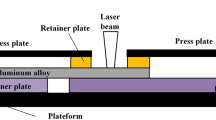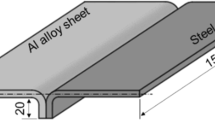Abstract
Laser direct joining of steel (DP590) and thermoplastic polycarbonate (PC) is conducive to promoting the lightweighting of automobiles. In this paper, the optimal laser parameters of laser direct joining of DP590 and PC were determined. To improve the interfacial bonding strength of DP590-PC joints, a linearly arranged groove was fabricated on the DP590 surface by a fiber laser. The influence of groove direction and spacing on the ultimate shear force of the DP590-PC joints was investigated through lap-shear testing, and the test results showed that groove direction had little effect on the joint force, but groove spacing had a significant effect. When a groove spacing of 0.15 mm was selected, the joint force increased by 52.5%. The effect mechanism of surface topography on joint force was further analyzed by a cross-sectional view, which revealed that the existence of surface topography can increase interface contact area and form a mechanical interlocking structure between DP590 and PC. In addition, the interfacial heat transfer of the joint during laser joining is affected by the surface topography. When the ratio of surface topography reached 40%, the joint force almost reached the maximum. The reason is that the excessive proportion of surface topography results in high temperature on the PC side and forms excess voids, which inhibits the improvement of joint strength. Therefore, the desired force of DP590-PC joint can be obtained by fabricating surface topography on steel surface.















Similar content being viewed by others
Data availability
Not applicable.
Code availability
Not applicable.
References
Das S, Acharya U, Rao SVVNS et al (2021) Assessment of the surface characteristics of aerospace grade AA6092/17.5 SiCp-T6 composite processed through EDM. CIRP J Manuf Sci Technol 33:123–132. https://doi.org/10.1016/j.cirpj.2021.03.005
Min J, Hu J, Sun C, Wan H, Liao P, Teng H, Lin J (2022) Fabrication processes of metal-fiber reinforced polymer hybrid components: a review. Adv Compos Hybrid Mater 1–28. https://doi.org/10.1007/s42114-021-00393-z
Lin Y, Min J, Teng H, Lin J, Hu J, Xu N (2020) Flexural performance of steel–FRP composites for automotive applications. Automot Innov 3(3):280–295. https://doi.org/10.1007/s42154-020-00109-x
Murray CJ (2015) Carbon fibers spearhead automotive lightweighting effort. Des News 70(7):42–43
Pattanayak S, Sahoo SK (2021) Gas metal arc welding based additive manufacturing—a review. CIRP J Manuf Sci Technol 33:398–442. https://doi.org/10.1016/j.cirpj.2021.04.010
Wannapa N, Uthaisangsuk V (2020) Experimental and numerical failure analyses of dissimilar material joints between aluminium and thermoplastic. Compos Struct 252:112762. https://doi.org/10.1016/j.compstruct.2020.112762
Tekkaya AE, Min J (2020) Special issue on automotive lightweight. Automotive Innovation 3(3):193–194. https://doi.org/10.1007/s42154-020-00117-x
Li J, Wang L, Chen Y, Lu H, Jiang H (2020) Research and application of lightweight index for passenger cars. Automot Innov 3(3):270–279. https://doi.org/10.1007/s42154-020-00110-4
Ma Y, Niu S, Shan H, Li Y, Ma N (2020) Impact of stack orientation on self-piercing riveted and friction self-piercing riveted aluminum alloy and magnesium alloy joints. Automot Innov 3(3):242–249. https://doi.org/10.1007/s42154-020-00108-y
Min J, Li Y, Li J et al (2014) Friction stir blind riveting of carbon fiber-reinforced polymer composite and aluminum alloy sheets. Int J Adv Manuf Technol 76:1403–1410. https://doi.org/10.1007/s00170-014-6364-8
Lee SJ, Kim JD, Jeong SUH (2019) Basic study of laser direct joining for CFRTP and metals using high power diode laser. J Weld Join 37(6):572–584. https://doi.org/10.5781/JWJ.2019.37.6.6
Jung KW, Kawahito Y, Takahashi M et al (2013) Laser direct joining of carbon fiber reinforced plastic to zinc-coated steel. Mater Des 47:179–188. https://doi.org/10.1016/j.matdes.2012.12.015
Schweier M, Haubold MW, Zaeh MF (2016) Analysis of spatters in laser welding with beam oscillation: a machine vision approach. CIRP J Manuf Sci Technol 14:35–42. https://doi.org/10.1016/j.cirpj.2016.05.004
Li P, Li J, Tan W et al (2018) Experimental study on the laser transmission joining of polystyrene and titanium. Materials 11(9):1513. https://doi.org/10.3390/ma11091513
Belitzki A, Stadter C, Zaeh MF (2019) Distortion minimization of laser beam welded components by the use of finite element simulation and artificial intelligence. CIRP J Manuf Sci Technol 27:11–20. https://doi.org/10.1016/j.cirpj.2019.10.001
Jiao J, Xu Z, Wang Q et al (2018) Research on carbon fiber reinforced thermal polymer/stainless steel laser direct joining. J Laser Appl 30(3):032419. https://doi.org/10.2351/1.5040627
Jung KW, Kawahito Y, Katayama S (2013) Laser direct joining of CFRP to metal or engineering plastic. Trans JWRI 42(2):5–8
Dawei Z, Qi Z, Xiaoguang F et al (2019) Review on joining process of carbon fiber-reinforced polymer and metal: applications and outlook. Rare Met Mater Eng 48:44–54
Schricker K, Bergmann JP (2019) Temperature- and time-dependent penetration of surface structures in thermal joining of plastics to metals. Key Eng Mater 809:378–385. https://doi.org/10.4028/www.scientific.net/KEM.809.378
Sheng L, Jiao J, Du B et al (2018) Influence of processing parameters on laser direct joining of CFRTP and stainless steel. Adv Mater Sci Eng 2018:1–15. https://doi.org/10.1155/2018/2530521
Ghanavati R, Ranjbarnodeh E, Shoja-Razavi R et al (2021) Experimental and numerical investigation of the effect of laser input energy on the mechanical behavior of stainless steel and polyamide joint in the LAMP joining method. Int J Adv Manuf Technol 113:3585–3597. https://doi.org/10.1007/s00170-021-06859-0
Lin J, Zhang J, Min J et al (2021) Laser-assisted conduction joining of carbon fiber reinforced sheet molding compound to dual-phase steel by a polycarbonate interlayer. Opt Laser Technol 133:106561. https://doi.org/10.1016/j.optlastec.2020.106561
Jiao J, Xu Z, Wang Q et al (2018) CFRTP and stainless steel laser joining: thermal defects analysis and joining parameters optimization. Opt Laser Technol 103:170–176. https://doi.org/10.1016/j.optlastec.2018.01.023
Meco S, Pardal G, Ganguly S et al (2015) Application of laser in seam welding of dissimilar steel to aluminium joints for thick structural components. Opt Lasers Eng 67:22–30. https://doi.org/10.1016/j.optlaseng.2014.10.006
Lambiase F, Genna S (2020) Homogenization of temperature distribution at metal-polymer interface during laser direct joining. Opt Laser Technol 128. https://doi.org/10.1016/j.optlastec.2020.106226
Jiao J, Wang Q, Wang F et al (2017) Numerical and experimental investigation on joining CFRTP and stainless steel using fiber lasers. J Mater Process Technol 240:362–369. https://doi.org/10.1016/j.jmatprotec.2016.10.013
Lambiase F, Genna S, Leone C et al (2017) Laser-assisted direct-joining of carbon fibre reinforced plastic with thermosetting matrix to polycarbonate sheets. Opt Laser Technol 94:45–58. https://doi.org/10.1016/j.optlastec.2017.03.006
Chen YJ, Yue TM, Guo ZN (2016) A new laser joining technology for direct-bonding of metals and plastics. Mater Des 110:775–781. https://doi.org/10.1016/j.matdes.2016.08.018
Acherjee B, Kuar A, Mitra S et al (2010) Finite element simulation of laser transmission welding of dissimilar materials between polyvinylidene fluoride and titanium. Int J Eng Sci Technol 2(4):176–186
Wang Q, Jia ZY, Zhang BY, Gao DL, Ma Y, Liu JY (2021) Influence of processing parameters on joint shear performance in laser direct joining of CFRTP and aluminum alloy. Mater Des 209:109996. https://doi.org/10.1016/j.matdes.2021.109996
Wang Q, Jia ZY, Zhang BY, Fu R, Liu JY, Han DZ (2022) Study on interface temperature control of laser direct joining of CFRTP and aluminum alloy based on staged laser path planning. Opt Laser Technol 154:108333. https://doi.org/10.1016/j.optlastec.2022.108333
Min J, Wan H, Carlson BE et al (2020) Application of laser ablation in adhesive bonding of metallic materials: a review. Opt Laser Technol 128:106188. https://doi.org/10.1016/j.optlastec.2020.106188
Rodríguez-Vidal E, Sanz C, Lambarri J, Quintana I (2018) Experimental investigation into metal micro-patterning by laser on polymer-metal hybrid joining. Opt Laser Technol 104:73–82. https://doi.org/10.1016/j.optlastec.2018.02.003
Wang F, Bu H, Luo J, Zhang P, Wang L, Zhan X (2022) Influence of different micro-pattern types on interface characteristic and mechanical property of CFRTP/aluminum alloy laser bonding joint. Int J Adv Manuf Technol 120(5):3543–3557. https://doi.org/10.1007/s00170-022-08748-6
Rodríguez-Vidal E, Sanz C, Soriano C et al (2016) Effect of metal micro-structuring on the mechanical behavior of polymer–metal laser T-joints. J Mater Process Technol 229:668–677. https://doi.org/10.1016/j.jmatprotec.2015.10.026
Jiao J, Jia S, Xu Z, Ye Y, Sheng L, Zhang W (2019) Laser direct joining of CFRTP and aluminium alloy with a hybrid surface pre-treating method. Compos B Eng 173:106911. https://doi.org/10.1016/j.compositesb.2019.106911
Zhen-xia DU, Guo-ying RAO, Ai-ling NAN, Shan-peng SONG (2003) The study of thermal degradation of polycarbonates. Polym Mater Sci Eng 19(3):164–167
Tan X, Zhang J, Shan J et al (2015) Characteristics and formation mechanism of porosities in CFRP during laser joining of CFRP and steel. Compos B Eng 70:35–43. https://doi.org/10.1016/j.compositesb.2014.10.023
Arkhurst BM, Seol JB, Lee YS, Lee M, Kim JH (2019) Interfacial structure and bonding mechanism of AZ31/carbon-fiber-reinforced plastic composites fabricated by thermal laser joining. Compos B Eng 167:71–82. https://doi.org/10.1016/j.compositesb.2018.12.002
Wan H, Min J, Carlson BE, Lin J, Sun C (2021) Spindle-shaped surface microstructure inspired by directional water collection biosystems to enhance interfacial wetting and bonding strength. ACS Appl Mater Interfaces 13(11):13760–13770. https://doi.org/10.1021/acsami.0c21857
Jun-wen LI, Hai-dong ZHAO, Chao-zhong WU, Yuan-yuan LI (2014) Interfacial heat transfer behavior of aluminum alloy during squeeze casting. Chin J Nonferrous Met 24(11):2727–2734
Funding
The work is financially supported from the National Natural Science Foundation of China (No. 51805375).
Author information
Authors and Affiliations
Contributions
Bo Chen: methodology, formal analysis, writing – original draft. Xiao Jiang: investigation, data curation, visualization. Junying Min: project administration, supervision, writing – review and editing, funding acquisition. Chengcheng Sun: validation, writing – review and editing. Yi Liu: resources, writing – review and editing. Shanglu Yang: writing – review and editing. Jianping Lin: writing – review and editing.
Corresponding author
Ethics declarations
Ethics approval
Not applicable.
Consent to participate
Not applicable.
Consent for publication
The manuscript is approved by all authors for publication; all the authors listed have approved the manuscript that is enclosed.
Conflict of interest
The authors declare no competing interests.
Additional information
Publisher's note
Springer Nature remains neutral with regard to jurisdictional claims in published maps and institutional affiliations.
Recommended for publication by Commission X-Structural Performances of Welded Joints-Fracture Avoidance
Rights and permissions
About this article
Cite this article
Chen, B., Jiang, X., Min, J. et al. Effect of surface topography on mechanical properties of steel-polycarbonate joints by laser direct joining. Weld World 66, 1811–1823 (2022). https://doi.org/10.1007/s40194-022-01344-y
Received:
Accepted:
Published:
Issue Date:
DOI: https://doi.org/10.1007/s40194-022-01344-y




